How to Give a Good Product Demo That Wins Customers?
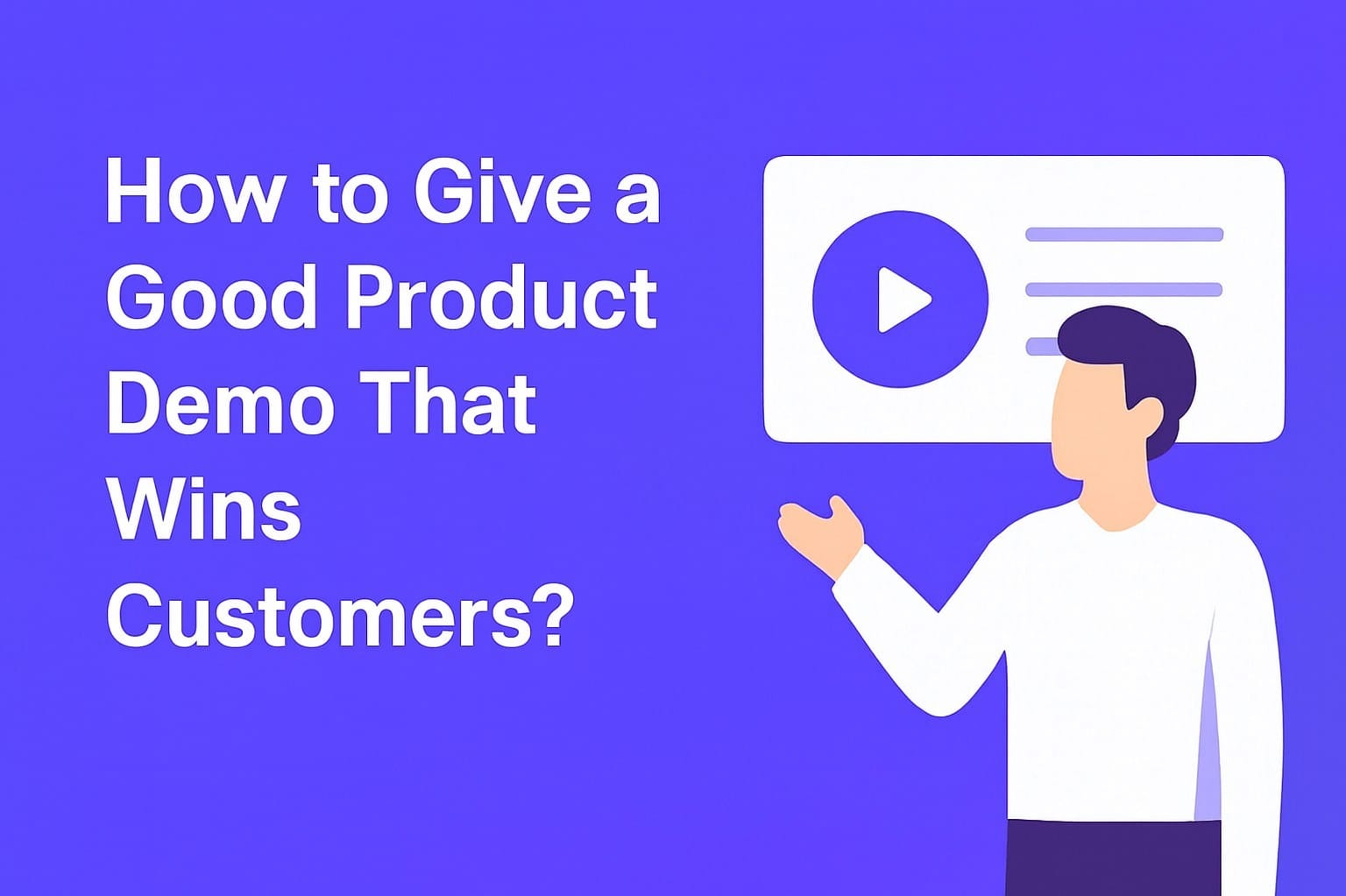
Key Highlights
A good product demo tells a story instead of listing features.
A demo proves value better than a sales pitch.
A strong demo feels like a dialogue, not a lecture.
Discovery makes demos personalized and impactful.
Focusing on key features creates clear “aha” moments.
Good demos don’t need to be perfect, just valuable.
SmartCue helps teams deliver fast, interactive, and personalized demos.
Your product is amazing, but your demo isn’t convincing anyone. If you are only showing features, you are leaving money and trust on the table.
The truth is, a good demo isn't about showing everything your product can do. It’s about telling a story that connects with your audience, highlights value, and makes them see your product as the answer they have been looking for.
In this blog, we'll share essential tips and tricks to help you deliver demos that win. From smart prep and engaging storytelling to keeping things interactive and handling tough questions, you'll learn how to turn every demo into a powerful sales moment.
What Is a Product Demo?
A product demo is more than just slides or talking points. Picture this: your prospect clicks through your software and suddenly sees their biggest headaches disappearing.
The dashboard that once took hours to update now does it automatically. A repetitive task that used to slow the team down is gone. Every feature you highlight is not just a bullet on a list, but a solution they can experience in real-time.
The goal is simple: make your product unforgettable. By starting with what frustrates your customers, telling a story that connects features to real wins, and showing only the tools that solve their problems, your demo turns curiosity into excitement and turns prospects into believers.
By the end, they are not just nodding politely; they are imagining themselves using your product every day.
What Makes a Product Demo More Convincing Than a Pitch?
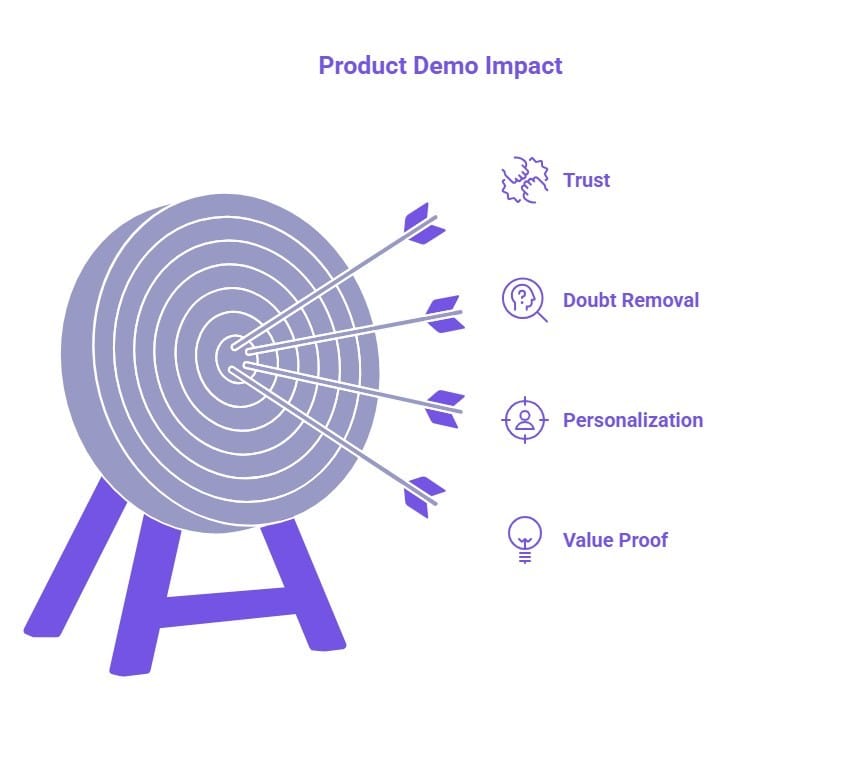
A sales pitch talks about what your product can do. A product demo shows it in action. That subtle difference is what makes demos so powerful. They transform abstract promises into tangible proof. As Bill Gates once said:
“If you show people the problems and you show them the solutions, they will be moved to act.” (source)
Demos go further than pitches because they do not just tell prospects about value, they let them experience it. Here is why:
Prove value in real time: Prospects see your product solving problems as it happens, making the impact immediate and undeniable.
Make it personal: Demos can address a customer’s specific pain points, showing how the solution fits their unique needs.
Remove doubt step by step: Walking through challenges and solutions live eliminates uncertainty and builds confidence.
Build trust through experience: Seeing the product work firsthand reassures prospects that it truly delivers on its promises.
Consider this real-world example. During a SaaS demo, a product manager watched a live workflow automation in action and said, “I finally get it. This will save my team hours every week." That moment of clarity, when potential turns into conviction, is something a pitch alone rarely achieves.
While a pitch can spark interest, a well-delivered demo creates confidence. It gives prospects a clear vision of how your product fits into their world and why it is the solution they truly need.
How Do You Turn a Live Demo Into a Deal-Closer?
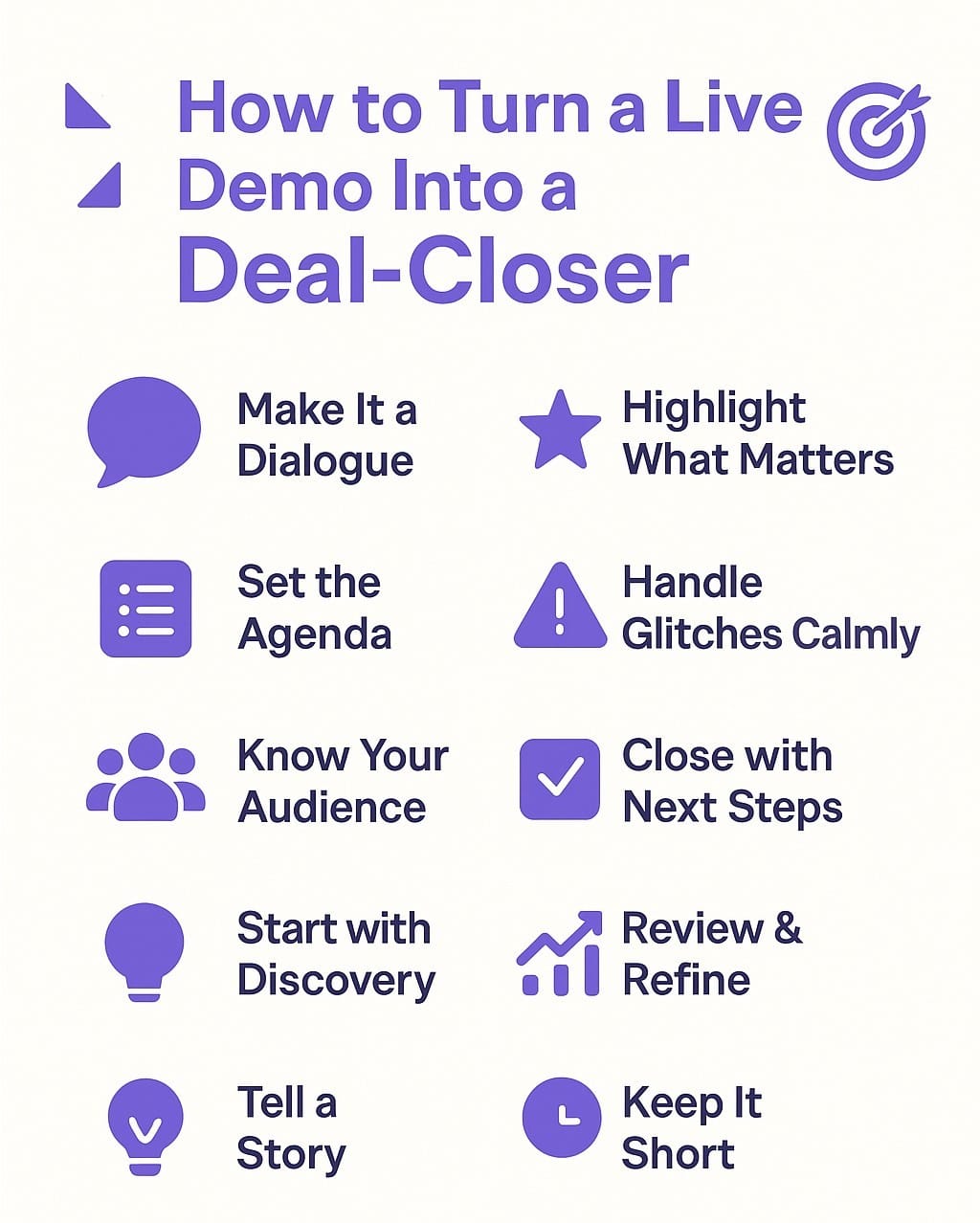
Delivering a great demo is more than showing off features. It means connecting with your audience, telling a clear story, and turning a product walkthrough into a conversation that drives conversions.
From setting the stage to closing with a strong call to action, these practices will help you run live demos that grab attention, solve customer needs, and leave a lasting impression.
1. Turn Your Demo Into a Dialogue
A winning demo feels like a conversation, not a lecture. Speak naturally and invite questions so your prospects feel heard.
For example, if you are walking through a reporting dashboard, pause and ask, “Would this save your team time each week compared to your current process?”
When a prospect replies, you can dive deeper into their workflow and show exactly how your product removes their pain point. This back-and-forth keeps the demo personal and builds trust.
2. Set the Agenda Early
Show prospects you value their time by setting expectations up front. Open with something attention-grabbing, like “Most teams spend ten hours a week on manual data entry.
Today I will show you how to cut that time in half.” Then walk them through your plan: “First, we will tackle data entry, then look at automation, and finally leave time for questions.”
With this roadmap, the demo feels structured, and prospects know what to expect.
This approach is one of the proven SaaS demo best practices that helps you guide conversations with confidence and clarity.
3. Read Your Audience
The more you understand your audience, the more powerful your demo becomes. When presenting to a sales manager, focus on pipeline visibility and quota tracking.
If your audience is a customer success leader, highlight churn reduction and engagement metrics. By aligning your examples to their role, you prove that your product speaks directly to their goals..
4. Run a Discovery Session First
A strong demo starts before the presentation. Use a discovery call to uncover your prospect’s challenges, goals, and pain points. Ask smart questions, listen closely, and gather the insights that matter most.
With this knowledge, you can tailor your demo to show exactly how your product solves their problems. Back it up with real examples, and you turn a standard walkthrough into a personalized solution your audience can’t ignore.
5. Focus on What Matters Most
Trying to showcase every feature can overwhelm prospects. Instead, highlight only the key functions that directly solve their pain points. Quality beats quantity in a demo.
Pick the top three or four features that align with their needs, solve their most pressing problems, and create clear “aha” moments. By narrowing your focus, you build a stronger story and make it easy for prospects to see the real value your product brings.
6. Handle Glitches with Confidence
Even the best-prepared demos run into technical hiccups. Imagine your integration fails to load during the call. Instead of panicking, you switch to a short pre-recorded clip and say, “Here is exactly how the integration looks when connected."
By moving smoothly to your backup, you keep control of the room and maintain credibility.
7. Close with a Clear Next Step
How you end a demo can decide what happens next. A weak close leaves prospects uncertain, while a clear call to action guides them forward.
Be direct. Ask them to book a follow-up, start a free trial, or explore a resource. You can also add a softer CTA, like sharing feedback or connecting on social channels, to keep engagement going.
A confident close reinforces your product's value and ensures your demo turns interest into action.
8. Review and Refine Every Demo
Every demo is a chance to improve. After each session, review what resonated. Did prospects lean in when you showed time savings? Did they go quiet when you talked about integrations?
For example, if three recent demos ended with the same question about security, you know it deserves a stronger spotlight next time. Tracking these patterns helps you sharpen delivery and avoid guesswork.
9. Tell a Story, Not Just Features
Features alone rarely win deals. What sticks is a story. Suppose you are selling project management software. Instead of listing collaboration features, tell the story of a client who went from missing deadlines to delivering ahead of schedule.
Walk through the challenge, the solution, and the outcome. When prospects can picture themselves in that story, the demo becomes far more persuasive.
To make your storytelling even more engaging, explore these tips on creating demo videos that captivate prospects and bring your product to life.
10. Keep It Short and Impactful
A demo that drags on can quickly lose attention. Instead of covering everything your product can do, focus on the essentials that align with the prospect's priorities. A tight 20- to 30-minute session keeps energy high and your message sharp.
Ending on a high note is better than overwhelming the audience with too much information. By keeping it concise, you make sure prospects walk away remembering the value, not the length, of your presentation.
What Tools Can Help You Deliver Better Product Demos?
Running a demo isn't just about preparation and delivery. The right tools can make the process smoother, more engaging, and far more reliable.
Let's look at some tools that can help you deliver demos with confidence and impact.
1. SmartCue
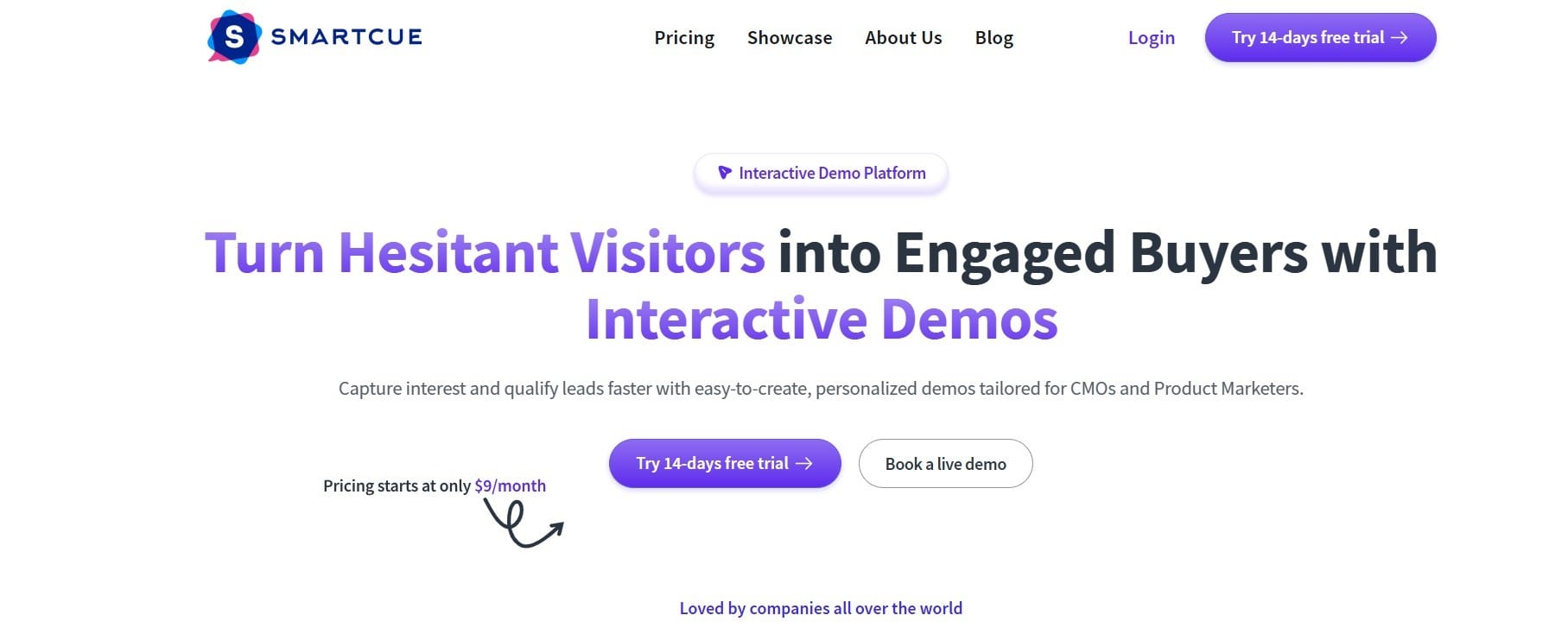
SmartCueis an interactive demo platform built for go-to-market teams. It helps sales, marketing, and product teams replace static videos or lengthy calls with engaging, hands-on demos that prospects can explore at their own pace.
What You Can Do With It
Record workflows instantly with a one-click Chrome extension.
Personalize demos with zoom, pan, blur, and callouts.
Share demos via embed, public or password-protected links, or export them as PDF, GIF, or video.
Track engagement with detailed analytics like time spent, drop-offs, and impressions.
Collaborate across teams with integrations for HubSpot, Salesforce, Seismic, and more.
Why Teams Love It
SmartCue is fast, simple, and flexible. Most demos take under six minutes to create, and the platform makes it easy to adapt for different audiences. Its analytics give clear insight into what resonates, while the no-code interface ensures anyone can use it without training.
Where It Falls Short
SmartCue is designed primarily for digital and SaaS products, so teams outside of software may find limited use cases. Its advanced personalization tools are powerful but may require some initial practice to master.
What You'll Pay
Essential: $99 per user/year
Growth: $300 per user/year
Enterprise: Custom pricing on request
2. Demoboost
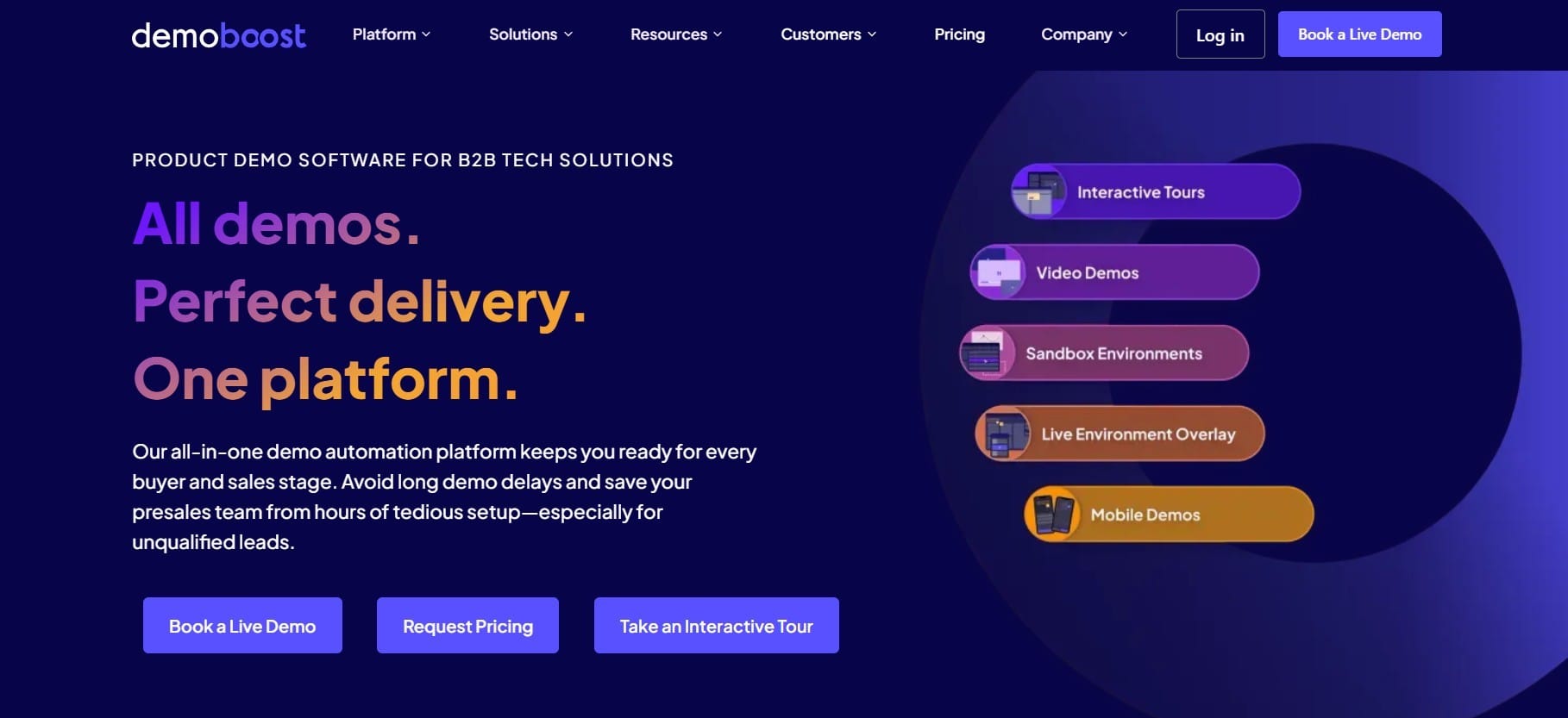
Demoboost is an all-in-one demo automation platform built for B2B software companies. It helps presales, sales, and marketing teams deliver consistent demos at every stage of the buyer journey, from website tours to onboarding.
By eliminating long demo delays and complex setups, Demoboost keeps teams demo-ready for both qualified and unqualified leads.
What You Can Do With It
Build interactive guided product tours, demo galleries, and sandbox environments.
Use overlays to customize live products instantly without extra dev work.
Deliver mobile-ready demos and videos for flexible formats.
Create digital sales rooms to share demos, collateral, and track stakeholder engagement.
Personalize journeys with demo menus and “pick your own path” experiences.
Rely on built-in speaker notes to ensure polished live delivery.
Why Teams Love It
Supports all demo formats: live, on-demand, sandbox, and tours.
Personalization makes demos highly relevant for each buyer.
Digital sales rooms simplify collaboration with multiple stakeholders.
Integrates with major GTM tools like Salesforce, HubSpot, and Slack.
Backed by expert training, playbooks, and ongoing customer success support.
Where It Falls Short
The broad feature set can feel overwhelming for new users.
Pricing isn’t transparent and requires a custom request.
Best Fit For
Demoboost is ideal for B2B SaaS companies with complex products that require different demo formats across the buyer journey.
What You’ll Pay
You can book a live demo or request pricing directly from their team.
3. Navattic
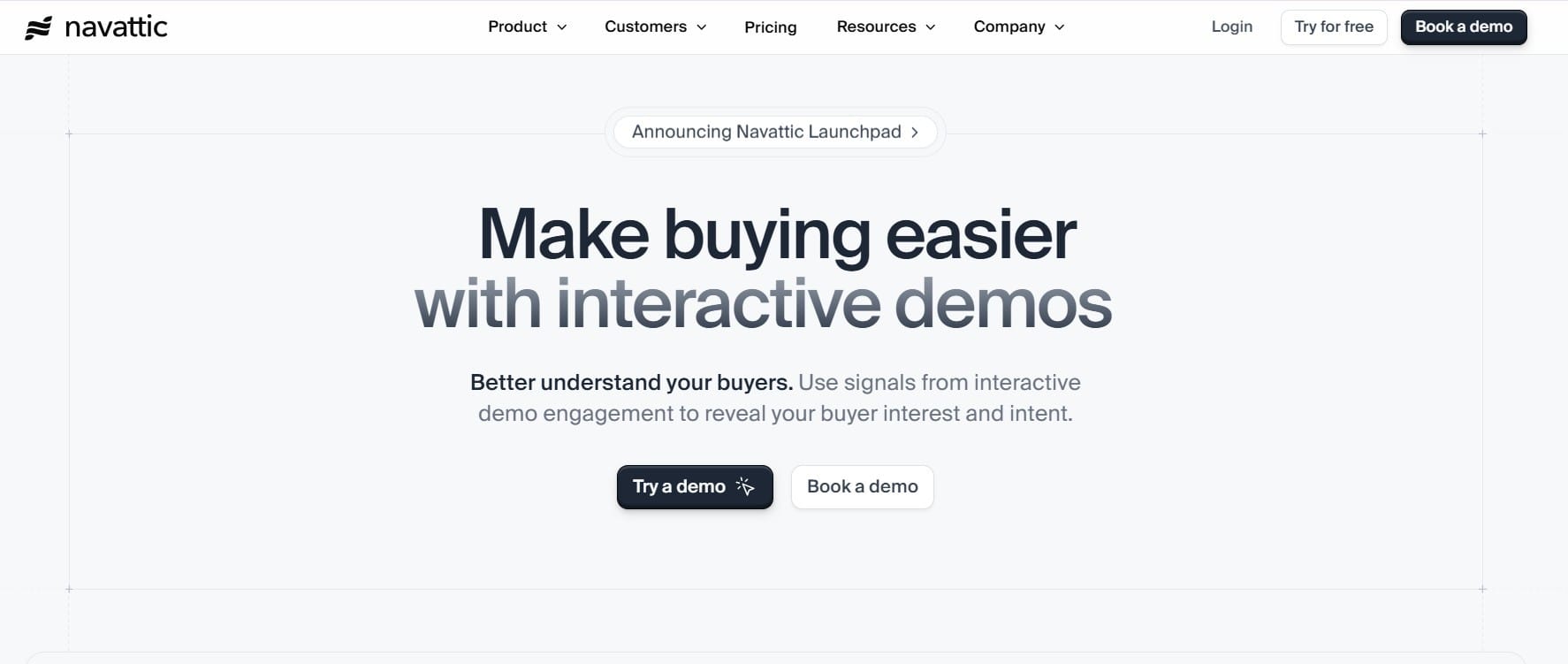
Navattic is a no-code interactive demo platform designed to make buying easier and smarter. It lets sales, marketing, and presales teams create self-guided product demos that reveal buyer intent through engagement signals.
With its insights-first approach, Navattic enables go-to-market teams to identify, qualify, and convert high-intent prospects more efficiently.
What You Can Do With It:
Build interactive demos with features like dynamic personalization, multilingual support, and offline access for events.
Guide prospects with “interest demos” that route visitors to custom flows.
Track engagement with advanced analytics, account-level tracking, and buyer intent alerts.
Use Playbooks to act on demo signals, sending updates to Slack, HubSpot, or email in real time.
Integrate with major GTM tools such as Salesforce, HubSpot, Segment, and Marketo.
Why Teams Love It:
Empowers sales and marketing to share demos earlier in the funnel without pulling in SEs for every call.
Provides deep engagement analytics to uncover high-intent accounts.
Personalization and multilingual options make demos accessible worldwide.
Offline demos extend use cases to trade shows and conferences.
Strong ecosystem of integrations for seamless GTM workflows.
Where It Falls Short:
Designed mainly for SaaS teams, so that non-software companies may find limited use.
Advanced analytics and filtering may require setup and training to unlock full value.
Best Fit For
Navattic is best suited for growth-focused SaaS companies that want to qualify website visitors, arm sales teams with self-serve demos, and capture buyer intent signals across the funnel.
What You'll Pay
Starter: Free
Base: $500/month
Growth: $1,000/month
Enterprise: Custom pricing on request
4. Storylane
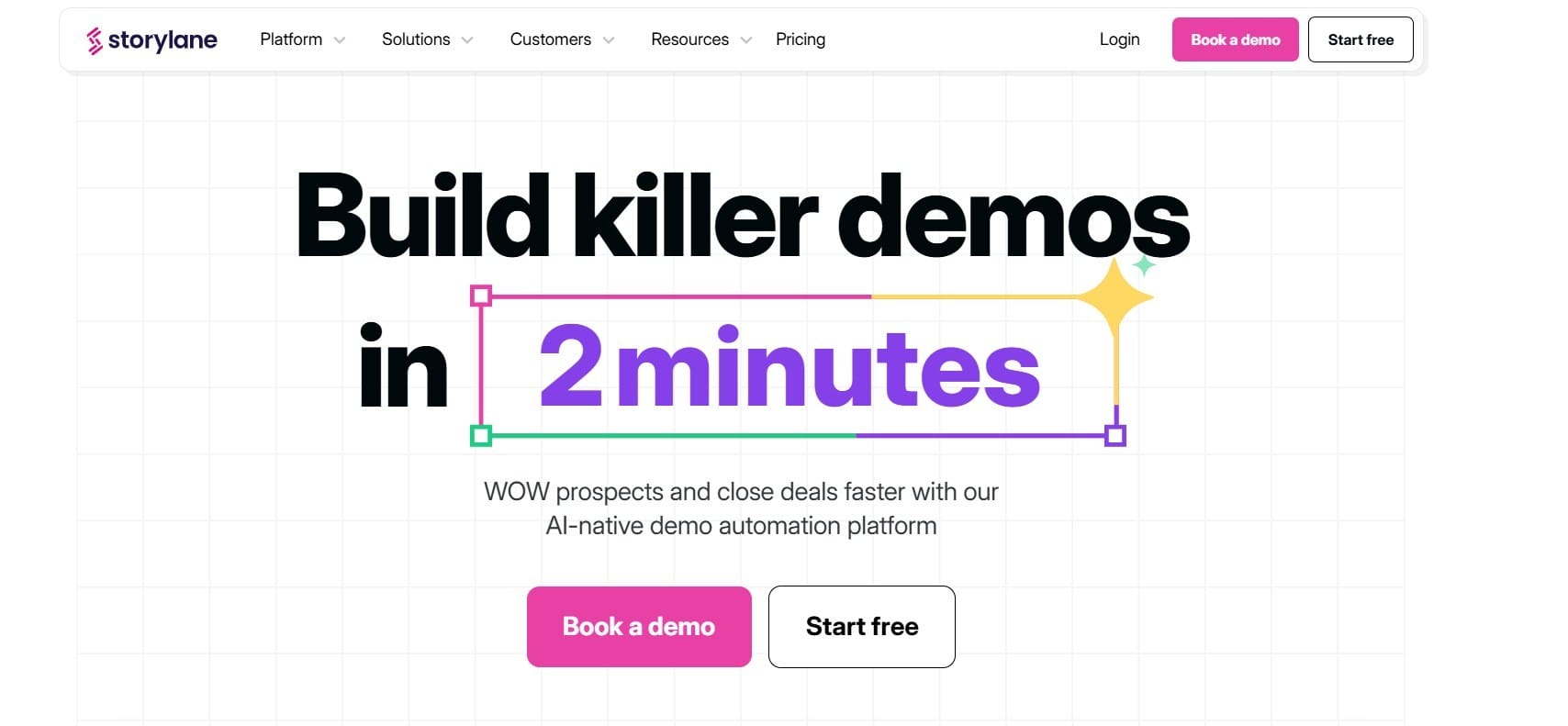
Storylane is an AI-native demo automation platform built to help GTM teams create interactive product demos in just minutes.
Loved by over 5,000 sales and marketing teams, it enables businesses to replace static videos with immersive demos that wow prospects, accelerate pipeline, and boost conversions.
What You Can Do With It
Capture product flows instantly with a browser extension that replicates real product screens.
Use AI-powered HTML editing to customize demos without developer support.
Generate demo content, voiceovers, and even AI avatars for human-like experiences.
Create different formats such as guided demos for product-led growth, sandbox demos for deep exploration, and buyer hubs to centralize resources.
Share or embed demos across websites, sales emails, campaigns, and events.
Analyze demo performance, deanonymize high-intent accounts, and synchronize engagement data with CRMs like Salesforce and HubSpot.
Why Teams Love It
Fast and simple setup with demos built in under two minutes.
Highly customizable with AI-driven personalization and editing.
Eliminates reliance on expensive video production.
Strong integrations with leading GTM tools, including Salesforce, HubSpot, Slack, and Marketo.
Proven results with customers reporting up to 3x engagement and 45 percent faster sales cycles.
Where It Falls Short
The AI-powered editing tools, while powerful, may require a learning curve for first-time users.
With its advanced feature set, Storylane may be more than smaller teams need.
Best Fit For
Storylane is ideal for fast-moving SaaS sales and marketing teams looking to create polished, AI-driven demos quickly.
What You'll Pay
Free: $0/month
Starter: $40/month
Growth: $500/month
Premium: $1200/month
Enterprise: Contact sales for pricing
How Can SmartCue Help You Win More Customers with Less Effort?
Most demos fail because they overwhelm prospects with information or take too long to set up. SmartCue changes that by making demo creation fast, interactive, and personal.
With SmartCue, you are not just showing features. You are creating guided experiences that align with your buyer's journey and drive real engagement.
Getting started with SmartCue is surprisingly simple. Here is what the process looks like:
Step 1: Sign Up and Dive In
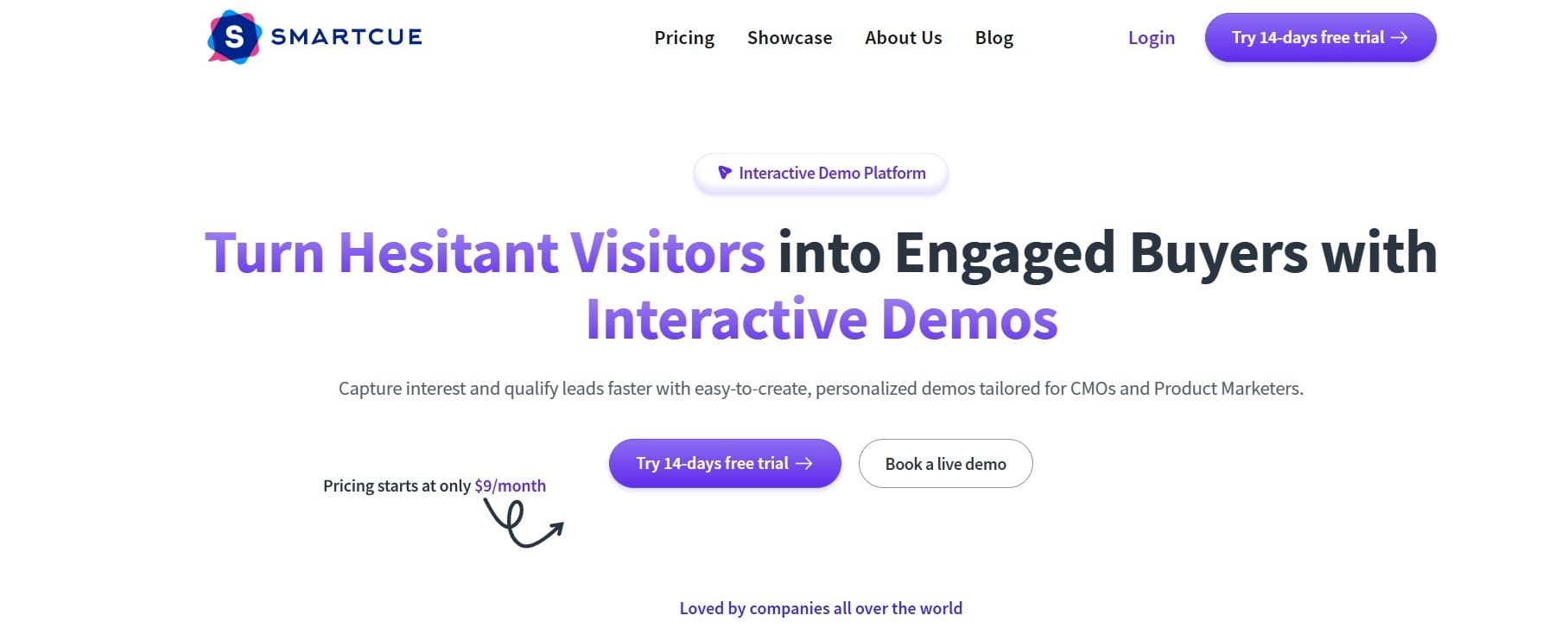
Kick things off by creating your free trial account. Within minutes, you'll be inside SmartCue's intuitive dashboard, ready to build your first demo.
Step 2: Capture Your Product Flow
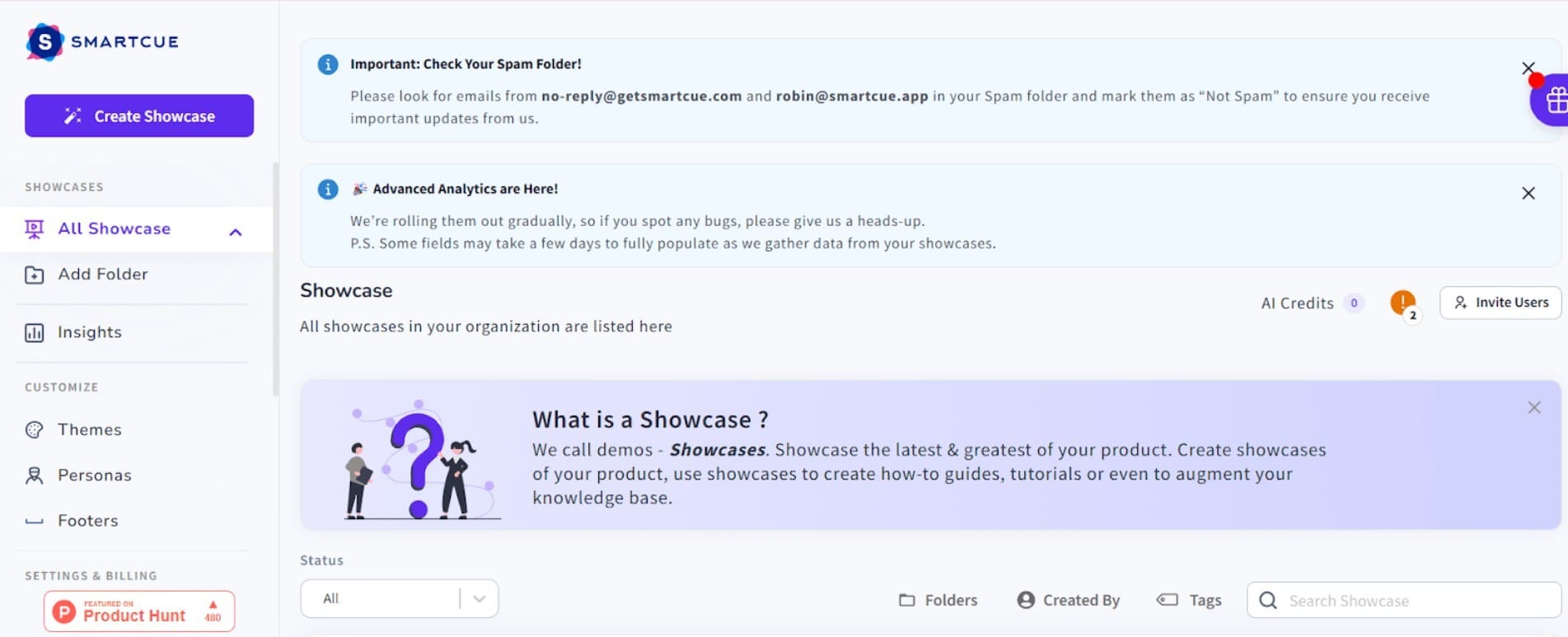
Use the Chrome extension to record real user journeys inside your product or pull in existing screens to form the base of your showcase.
Step 3: Personalize Every Detail
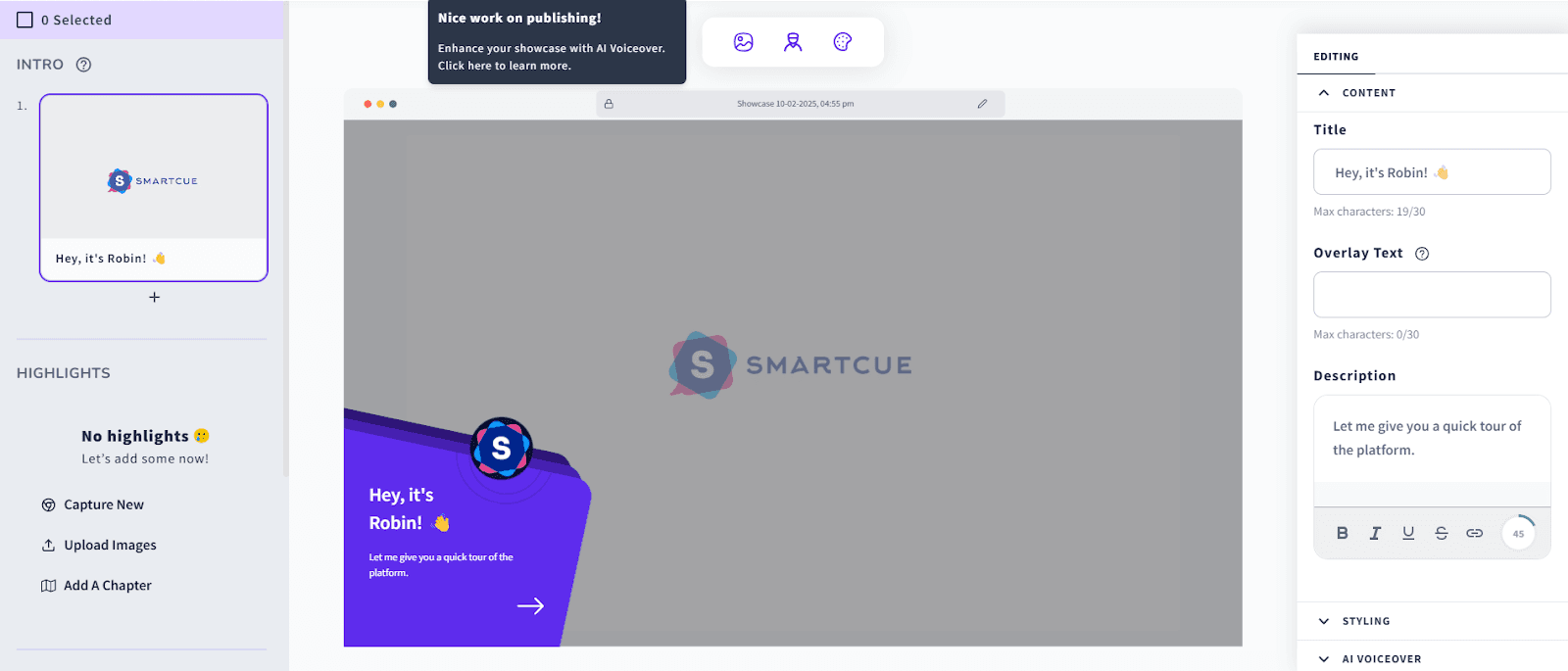
Highlight the features that matter with zooms and callouts, blur sensitive fields, and shape different flows for different audiences so every demo feels tailor-made.
Step 4: Share with Prospects Anywhere
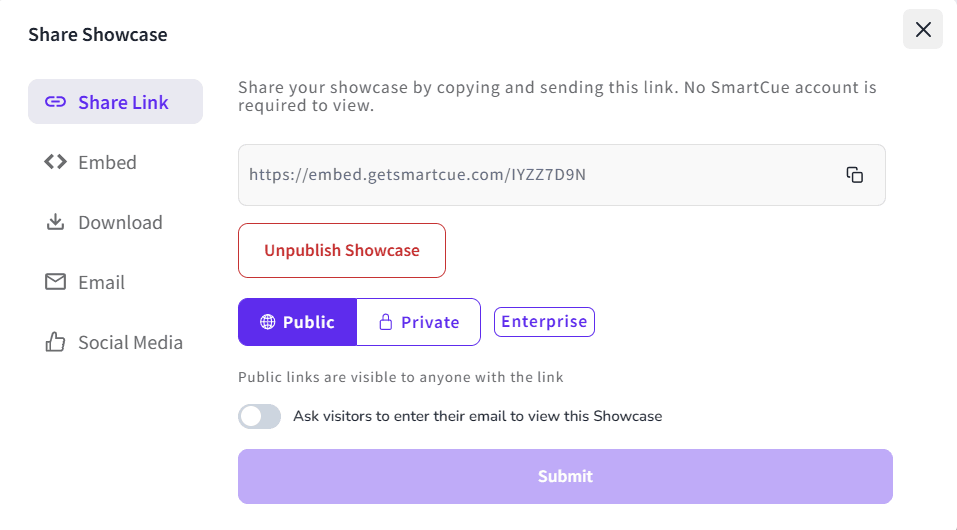
Go live in a single click. Whether you embed on your website, drop into a campaign, or send a secure link, your demo is always easy to access.
Step 5: Measure and Refine
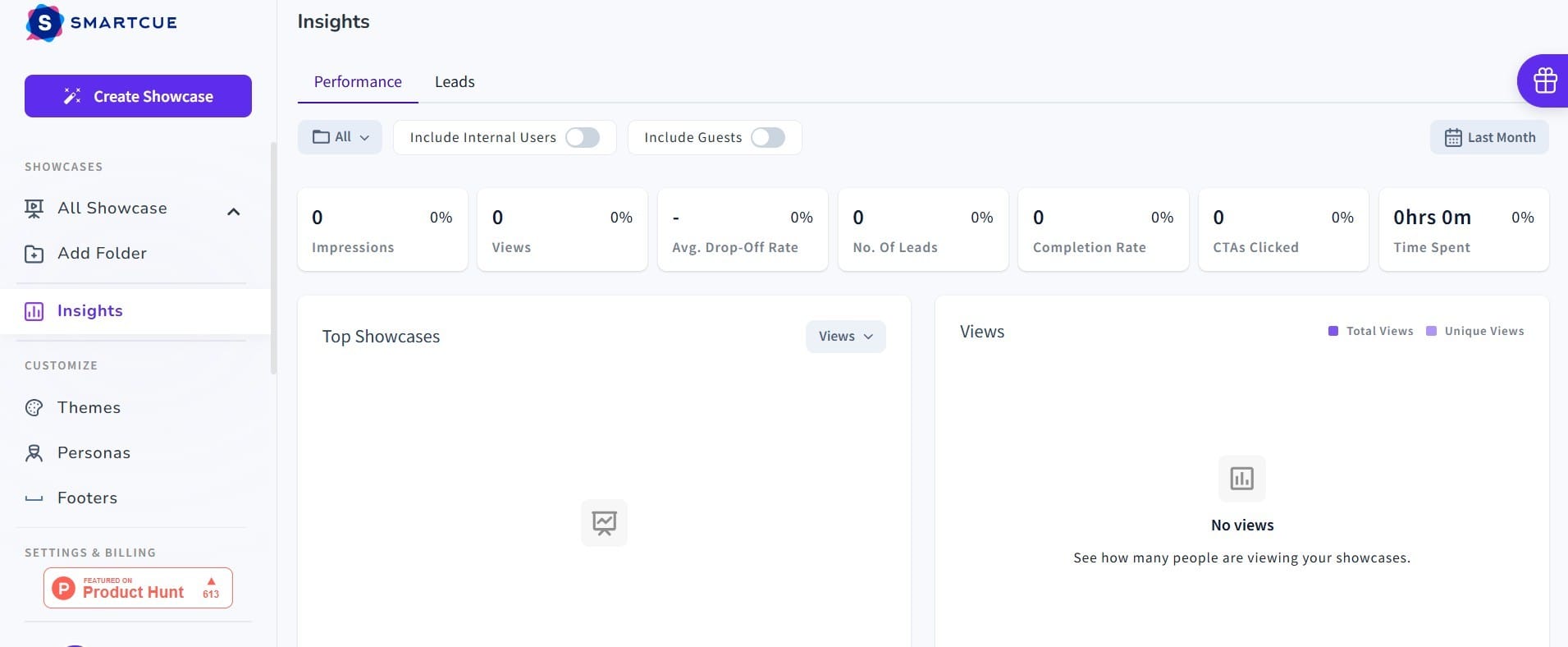
Check analytics to see how prospects engage, from clicks to drop-offs. Use those insights to qualify leads faster and keep making your demos sharper.
Ready to experience it firsthand? Start your 14-day free trial today.
Your Next Demo Could Change Everything
Think of your next demo as more than a presentation. It is your chance to spark excitement, build trust, and move a prospect one step closer to becoming a customer. Every interaction is an opportunity to stand out, but only if you deliver it with clarity and impact.
So take the leap. Open up the tools, design a demo that speaks directly to your audience, and put it in their hands.
The sooner you start, the sooner you will see the difference between just showing a product and actually winning with it.
Frequently Asked Questions
What are the most common mistakes to avoid during a product demo?
The biggest mistakes include failing to research your target audience, overlooking key problems, and delivering a one-size-fits-all product demonstration. Sales reps also lose impact when they ignore decision makers’ biggest concerns or overload the entire demo with product features.
How can I make my product demo stand out if I'm not a salesperson?
Focus on authenticity and tell a story tied to a specific use case. Share how your solution addresses a customer problem. A personal, relatable approach often resonates more with potential customers than polished email campaigns or landing pages.
How to make a good product demo video?
To create an effective product demo video, use tools that record both the screen and camera, include simple editing features, and allow for custom branding. This makes it easy to build polished video demos that elevate your software demo or marketing strategy.
How do I structure my demo for maximum impact?
Start with a hook to capture attention, then focus on solving key details of the customer problem. Showcase only the most valuable product features, reinforce them with case studies, and conclude with a clear call to action in your product demo video.
How to record a good product demo?
To record a good product demo, start by scripting around your target audience’s key problems instead of listing features. Use a reliable screen recorder with clear audio, add callouts for key details, and keep the demo concise. End with a clear call to action to guide potential customers.
What's the best product demo video you've seen?
The best product demo video is one that tells a story instead of listing product features. For example, Dropbox’s early explainer was simple, straightforward, and directly solved a customer problem, making it both memorable and effective.
How to make Zoom demos more exciting/engaging?
Keep your Zoom demo interactive by involving the target audience. Ask quick check-in questions, share a specific use case, and spotlight only the most valuable product features. Using visuals, polls, or short video demos also helps break monotony.
Comments
Your comment has been submitted successfully!